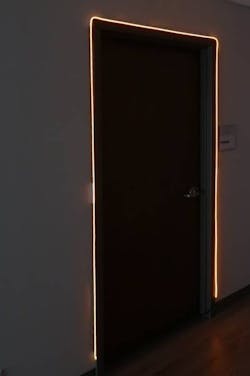According to the National Institutes of Health, more than one in four adults 65 and older experience a fall annually, often leading to serious injury or even death. While falls can happen at any time, initial research from the Mount Sinai Light and Health Research Center (LHRC) suggests that visual-cue lighting can reduce nighttime falls among older adults in institutional settings by more than 30%.
“Falls are the number one reason that older adults are institutionalized,” Daniel Frering, LHRC education program director, told LEDs Magazine. “Especially in much older people, people in their 80s — they typically don’t live a long time after they fall. If you can prevent falls, the health outcomes for older people are going to be greatly improved.”
Today, the LHRC team is partnering with faculty at the University of North Carolina at Chapel Hill (UNC), to extend its research to a larger assisted living population this year. This is the next step toward ultimately testing visual-cue lighting in people’s homes, where the researchers see the system having its greatest benefit. The system they propose wraps a doorframe with amber-colored LEDs that emit a low luminance level.
Before that can happen, the researchers need a manufacturer to produce an easy-to-install visual-cue lighting system that is readily available — and ideally covered by Medicare/Medicaid, Frering said. “If you’re an older person [at home], or you’re a caregiver of an older person, you want to be able to go to your local hardware store and purchase a system that could come in a package that [can] Velcro around the door and … plug into a nearby socket in the wall,” Frering said. “That system does not exist right now.” A hardwired, commercial-grade system currently exists outside of the research prototype.
A job for LEDs
For approximately 15 years, Mariana Figueiro, LHRC director and professor of population health science and policy at the Icahn School of Medicine at Mount Sinai, has been studying the use of visual-cue lighting to reduce falls among older adults. Her research may not only improve lives, but also prolong them.
While working in the physical therapy department at Russell Sage College in the early 2000s, Figueiro wondered if lighted horizontal and vertical visual cues could improve stability among older adults and help prevent nighttime falls. She hypothesized that the lighting could provide a visual reference point, helping older adults orient themselves in space as they rise from a bed or chair.
The perfect anchor for these visual cues? A doorframe.
Figueiro and her team searched for lighting that could conform to the shape of a doorway and turned to LEDs. “LEDs are the only light source that could really do this,” Frering said. “[T]hey can come in a strip that almost looks like a piece of neon. These strips are typically flexible and can be easily mounted around a door.”
Establishing a visual connection
With their lighting system developed, the researchers conducted a laboratory study to test their hypothesis that visual cues can affect stability in older adults. They hung their system around a wooden frame with the dimensions of a standard doorframe, and then asked 12 test subjects — six men and six women, all 65 and older — to rise from a seated position to standing in front of the frame. As each individual rose, they stood on a force plate, which measured how long they took to stand and their stability and sway velocity while standing.
For their initial experiment, the team positioned the illuminated frame plumb. They subsequently skewed the frame 10 degrees to the left and then 10 degrees to the right to see how the system’s orientation would impact the subjects’ stability. When the frame was true, the subjects remained steady. But when it was tilted, the subjects leaned with the tilt.
“What we were showing in that study was that they were using their visual system to maintain their balance,” Frering explained, adding that older people rely mostly on their visual system to maintain stability in space. “When we’re young, all the systems in our bodies — our vestibular system and everything — help us maintain balance.” An older person would find it difficult, for example, “to stand on one leg and close their eyes because once they lose that visual sense of the world around them, they become unstable.”
Acceptability and effectiveness
In 2008, after confirming their visual-cue theory, the researchers partnered with an assisted-living facility to determine whether residents would like the lighting system. They installed the system around the bathroom doorframes in 12 units, each located about 10 feet from the bed. During the six-month study, a bed-mounted occupancy sensor turned on the LED strip whenever someone moved about the room. Because this was strictly an acceptability study, the researchers did not gather data about fall number.
The residents all found the lighting system acceptable, and the nurses found it helpful, too. “The nurses could go into the room at night, and they didn’t have to turn on the bright overhead lights to check on the patients,” Frering explained.
Fast forward to 2019. The researchers expanded their research, partnering with UNC for a yearlong study to determine whether their luminous doorframe system could reduce falls among assisted-living residents with Alzheimer’s disease. The team installed the system around bathroom doorframes in 38 rooms and set each system on a timer that automatically turned on the LEDs at 7 p.m. and off at 7 a.m. The lights emitted a steady low-luminance glow between those hours while motion-activated infrared cameras monitored how the system affected residents. “These cameras would come on, and [we] would analyze the stability of the person,” Frering said.
In this study, he continued, the researchers found that “falls were reduced by 34% in rooms that had these doorframe lighting systems, so it was a significant reduction in the number of falls.”
Scaling up
Today, the LHRC researchers are preparing to expand their work to a larger assisted-living population to try and replicate their results. Over the next four years, the study will involve 390 residents from 42 assisted-living communities in and around the UNC Chapel Hill area.
The researchers will package and deliver the light system as a kit that the UNC team can easily mount around each doorframe. The system will be used in conjunction with an artificial intelligence platform that detects falls. UNC faculty will be leading the study, and LHRC researchers will assist with the study design and data analysis.
While the UNC study will provide critical data, Frering anticipates the day when they can test the lighting system in people’s homes and engage a manufacturer to produce a system that people can purchase and install themselves. The researchers also want to leverage the study results to convince Medicare/Medicaid to cover the system; obtaining this coverage will help groups of people that have been historically marginalized — and are more likely to be institutionalized after a fall — access the system.
“Our hope is that this is something that can be deployed in people’s homes,” Frering said. “It is really about health equity. We want to do something that can assist low-income people and people of color to stay in their homes safely for a longer period of time.”
More on lighting for senior care & wellbeing
Biologically tuned lighting slashes falls at senior care homes
DOE’s PNNL reports on tunable SSL research at senior nursing center
For up-to-the-minute LED and SSL updates, follow us on Twitter. You’ll find curated content and commentary, as well as information on industry events, webcasts, and surveys on our LinkedIn page and our Facebook page.











